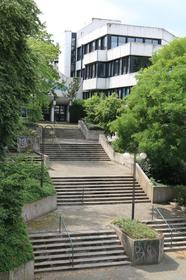- Davis Applied Technology College (formerly Davis Area Vocational Center) was created by an act of the 1978 Utah State Legislature to serve the residents of Davis and Morgan Counties with technical training. In June 2001, a special session of the Legislature passed House Bill 1003 creating the Utah College of Applied Technology (UCAT), the state's 10th newest institution of higher education. There are eight applied technology campuses: Bridgerland, Davis, Dixie, Mountainland, Ogden-Weber, Tooele, Southwest, and Uintah Basin. We are a trusted learning community embracing technical education to promote economic growth and student development. Our vision is recognition regionally, nationally and internationally for our unique approach and significant contributions in technical training, educational advancement and economic development. We value students, faculty and staff as individuals and empower them through respect and equitable treatment. We celebrate personal, cultural and ethnic diversity. We take pride in cost-effective training and flexible scheduling that allows students to prepare for careers or update skills. We promote career and educational pathways by providing hands-on, competency-based training. Our curriculum reflects the most recent technological and theoretical development to meet employer and student needs.
School Highlights
Davis Technical College serves 5,480 students (16% of students are full-time).
The college's student-teacher ratio of 19:1 is higher than the state community college average of 16:1.
Minority enrollment is 26% of the student body (majority Hispanic), which is less than the state average of 29%.
Quick Facts (2025-26)
- Enrollment: 5,480 students
- Student-teacher ratio: 19:1
- Minority enrollment: 26%
- Source: Integrated Postsecondary Education Data System (IPEDS)
School Overview
The teacher population of 294 teachers has stayed relatively flat over five years.
Davis Technical College
(UT) Community College Avg.
Carnegie Classification
Not applicable, not in Carnegie universe (not accredited or nondegree-granting)
Not applicable, not in Carnegie universe (not accredited or nondegree-granting)
Institution Level
Less than 2 years (below associate)
Four or more years
Institution Control
Public
Public
Year Founded
1978
Total Faculty
294 staff
215 staff
Number of Programs Offered
35
23
School Calendar
Student Body
The student population of Davis Technical College has grown by 47% over five years.
The student-teacher ratio of 19:1 has increased from 13:1 over five years.
The Davis Technical College diversity score of 0.42 is less than the state average of 0.47. The school's diversity has grown by 8% over five years.
Total Enrollment
5,480 students
4,285 students
Student-Teacher Ratio
19:1
16:1
# Full-Time Students
891 students
891 students
# Part-Time Students
4,589 students
3,394 students
# Enrollment Undergraduate
548 students
367 students
# Full-Time Undergraduate Students
891 students
891 students
# Full-Time Graduate Students
n/a
133 students
# Part-Time Undergraduate Students
4,589 students
3,394 students
# Part-Time Graduate Students
n/a
563 students
Total Dormitory Capacity
n/a
750 students
% American Indian/Alaskan
1%
1%
% Asian
1%
2%
% Hispanic
16%
13%
% Black
2%
1%
% White
74%
71%
% Hawaiian
1%
1%
% Two or more races
3%
3%
% Non Resident races
n/a
4%
% Unknown races
2%
4%
Diversity Score
0.42
0.47
College Completion Rate (Students who graduate in less than 4 years)
37%
65%
College Completion Rate (Students who graduate in 4 years or more than 4 years)
n/a
47%
Average Graduate Earnings (10 Years)
$32,600
$32,700
Tuition and Acceptance Rate
% Students Receiving Some Financial Aid
38%
73%
Median Debt for Graduates
n/a
$15,108
Median Debt for Dropouts
n/a
$6,334
Acceptance Rate
n/a
93%
SAT Reading
n/a
545
SAT Math
n/a
550
ACT Composite
n/a
23
ACT English
n/a
24
ACT Math
n/a
23
Source: 2024 (or latest year available) Integrated Postsecondary Education Data System (IPEDS)
Recent Articles

Community Colleges: A to Z – 2025 Guide
Explore the A–Z of community colleges in 2025: programs, affordability, pathways, and innovations for educators and parents.

Community College vs. Dual Enrollment 2025
Compare community college and dual enrollment in 2025. A parent’s guide to affordability, transfer credits, and student success pathways.

Will My Child’s Credits Transfer? Parent’s 2025 Guide
Learn how to ensure your child’s credits transfer in 2025. A parent’s guide to transfer policies, pitfalls, and planning for success.










